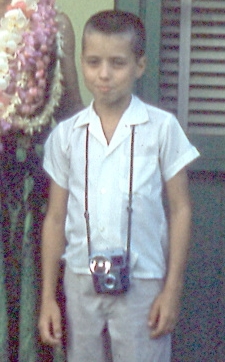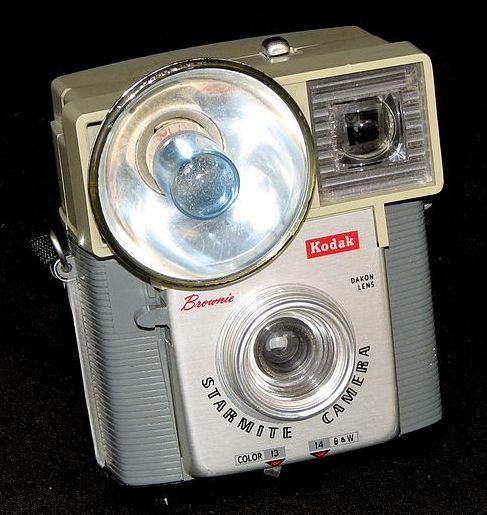Through the Years
- The Brownie
- The 126
- The 110
- Army Years - Part 1
- Army Years - Part 2
- Army Years - Part 3
- Army Years - Part 4
- Army Years - Part 5
- Army Years - Part 6
- Working in a Photofinishing Lab
- Industrial Era - Part 1
- Industrial Era - Part 2
- The 2nd Career
- Into the Fine Arts - Part 1
- Into the Fine Arts - Part 2
Photography Hardware
Processes and Projects
- Main workshop page
- Camera Building
- Pinhole camera
- Camera obscura
- Cyanotype project
- Sabattier effect
- Posterization
- Time Shifting
Photography Galleries
Photography Class Galleries
Links
Cameras
I mention a few of the cameras I have encountered in the Through the Years section, shown in the menu on the left, but here I want to go into a little more detail about each camera. A few of these I bought over the years and others, especially the older ones were given to me. I have shot at least one roll of film with most of them.
The camera itself is not a necessary piece of equipment in the pursuit of photography as there are many methods of making photographs without a camera such as photograms and cyanotypes. There are also homeade cameras such as the pinhole cameras I show in the Pinhole camera page. For me, I do like a good camera but as long as it captures the image I want, it is fine with me. Compared to some I've known, I am really not that much of an equipment junkie, more of a process junkie.
|
My first camera was a Kodak Brownie Starmite. I was a bit hazy about which model it was but after scanning some old family slides I found the photo at the right, top. I remember asking for a camera when we lived in Hawaii in the early 1960s and my parents got me this one. It was sort of expensive at the time, $10.50. The Starmite was made from 1960-1963. |
 
|
|
|
While not actually mine at the time, I believe I was using my parent's Kodak 126 Instamatic Model 104 for the pictures I shot during my high school years and shortly after. I have the camera now and assume that it still works. There are some pictures taken with this on The 126 page. |
 |
|
|
I picked up this camera in 1972 and used it quite a bit until I got into 35mm in the summer of 1973. It took marginal pictures due to its cheap lens and the small negative size but these cameras were extremely popular. There are more details and sample pictures on the The 110 page. |
|
|
|
This Minolta SRT-100, purchased in 1973, was my first 35mm camera and my entry point into serious photography. I detail this on the Army Years - Part 1 page. It came with a 55mm lens and with it I bought a strap and several rolls of black and white film. |
|
|
|
The Rolliecord VB was purchased in Germany in February 1975 for $152.55. That was substantially less than I could have bought it for on the civilian market back in the states so I figured that if I was going to get into medium format, this was a good deal. It takes superb pictures and has been a great camera up to the present time as it still works like new. |
| |
|
|
||
|
This Minolta SRT-201 body was purchased, well, I am not sure. It was in the 1970s, probably after I returned from Europe. I wanted a second body so I could carry two types of film on my outings, such as color in one and black and white in the other. It is almost identical to the SRT-100 but has a higher shutter speed (1/1000/sec), a hot shoe, and a self timer. |
|
|
|
This Konica C-35 is a nice little 35mm rangefinder. I think this one belonged to my grandmother and it eventually found its way to me. The camera is very basic but had auto-exposure, built-in flash, the first compact 35mm camera with that feature. I put fresh batteries in it and the flash works but the auto-exposre is not registering on the needle in the viewfinder. |
| |
|
In the early 1980s I decided I needed/wanted a fancier medium format camera. There were, of course, lots of choices and some were outside the budget number I had come up with and when I examined this Mamiya 645 1000S system it seemed to check all the boxes. I shopped around for this and ended up buying it, on sale, from Frank's in Highland Park. It not only was a good price but they through in the power-winder for free. With the camera I picked up: |
|
|
|
| ||
|
This is a Yashica TL-Electro 35mm camera that belonged to my dad. At some point he decided he didn't need it anymore and gave it to me. It came with a normal lens, a 28mm wide-angle, and a 90-230mm zoom. That zoom is one that I bought and rarely used and had given to him years before. I have used the camera a few times over the years, mostly just to keep it exercised. |
|
|
|
I bought this Bolsey Model B2 at an estate sale. The camera bag was locked and I bought it blind with a couple other antique cameras. After I got it home and picked the lock I discovered a complete camera system. There was the camera, lens convertors, tripod, filters, flash attachments, flash bulbs, a rangefinder, light meters, and numerous other accessories. There was even a roll of Kodak Tri-X film, expired in 1957. I have used the camera few times and while it's not a great camera in terms of image quality, it's fun to use and a trip back in photographic history. |
|
|
|
| ||
|
This little folding camera is really cool. I bought it with another camera at an estate sale as part of a package deal. It takes 120 film and is in great shape. I have used it in the past year and the photos are nice and sharp and, I think, in a 6x7 format. |
|
|
|
| ||
|
The following are all hand-me-down cameras, mostly from relatives who knew I was into photography and figured I needed another camera. | ||
|
This was my parent's 110 format camera. |
| |
|
Minolta Autopak 600X. Rangefinder. Uses 126 film. Has a flashcube with two shots left. |
| |
|
Minolta Freedom Tele. 35mm. This is actually a pretty nice, semi-automatic camera. Takes really nice pictures. It has auto-focus, uses films (DX coded) from ISO 50 to 3200. Built-in flash. Minolta even made a varient of this model for Leica as the AF-C1. I need to get this out and shoot some. |
| |
|
The Minolta 16 P. The original spy camera. My dad picked this up while overseas and I am not aware that he ever used it. These cameras were popular about the time the 110 format came out and superceded them. It used 16mm film that came in a cartridge. Although long discontinued, some people still reload the old cartidges use the cameras. |
| |
|
A very nice Kodak Brownie Junior. |
|
|
|
Another old Kodak camera. |
|
|
|
This little box camera is pretty old and I really know nothing about it. Metal case. Shutter works. |
| |
|
I think this was called a Kodak No. 1 Pocket Camera back in the day. It is the folding type and took some very large roll film. I think this belonged to my grandfather's sister. It's a bit dusty but cleaned up it's a nice piece to look at. |
| |
|
| ||
|
This wind-up movie camera belonged to my great-grandmother. It's from the 1930s and still works. It is a Bell and Howell Filmo Sportster 8mm. It is a "dual run" camera which means that the film was actually double-perforated 16mm film. After running through the camera you would flip it around and run it again. When sent in for development they would slit the film and splice to two pieces together. |
| |
|
| ||
|
This was my parents' 8mm movie camera that shot most of our home movies until my dad upgraded to Super 8 in the late 1960s. For its time, this camera was pretty plush with the two lenses mounted on a turret and multiple frame speeds. I've used it to make some stop-action animation since it has a single frame release feature. |
| |
|
| ||
|
A later addition to the camera stable was this Canon Powershot A560 digital camera. This was way before we had cell phones and relied on the cameras in them for everyday shooting. This little gem worked great. Aside from doing the usual family pictures I used its macro feature to copy medium format negatives in conjunction with my enlarger and a cast acrylic diffuser. It worked amazingly well for this purpose. |
| |
|
| ||
Click on an image to enlarge it.
Updated January 2021.

